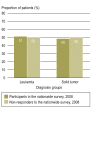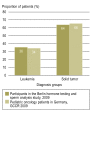Suspected infertility after treatment for leukemia and solid tumors in childhood and adolescence
- PMID: 22427790
- PMCID: PMC3301974
- DOI: 10.3238/arztebl.2012.0126
Suspected infertility after treatment for leukemia and solid tumors in childhood and adolescence
Abstract
Background: With improved cure rates of cancer in children and adolescents, the long-term effects of oncological treatment, including impaired fertility, have become an important clinical issue.
Methods: In 2008, we conducted a nationwide survey in Germany in which we asked 4689 female and male patients who had been treated for cancer in childhood or adolescence for information on menstruation, previous fertility testing (if any), attempts to conceive, and pregnancies. In a complementary study carried out in 2009, 748 former cancer patients in Berlin were offered hormone testing and sperm analysis. The defined criteria for suspected infertility were, in women, anti-muellerian hormone levels below 0.1 ng/mL; in men, FSH levels above 10 IU/L and inhibin B levels below 80 pg/mL, or azoospermia.
Results: The respondents to the nationwide survey included 1476 leukemia survivors and 1278 persons who had had a solid tumor. 104 former leukemia patients and 96 former solid tumor patients had already undergone fertility testing, leading to the suspicion of infertility in 26% and 34% of the persons in these respective groups (95% confidence intervals [CI], 18%-34% and 25%-43%). The patients who were tested in the Berlin study included 59 leukemia survivors and 104 persons who had had a solid tumor. The frequency of suspected infertility in these two groups was 25% and 27%, respectively (95% CI, 14%-36% and 18%-36%).
Conclusion: Up to one-third of adults who undergo fertility testing after having been treated for cancer in childhood or adolescence have suspected infertility. Patients and their parents should be counseled about the possibility of infertility and about fertility-preserving measures.
Figures


Comment in
-
Fertility in survivors of childhood cancer.Dtsch Arztebl Int. 2012 Feb;109(7):124-5. doi: 10.3238/arztebl.2012.0124. Epub 2012 Feb 17. Dtsch Arztebl Int. 2012. PMID: 22427789 Free PMC article. No abstract available.
References
-
- Robert-Koch-Institut und die Gesellschaft der epidemiologischen Krebsregister in Deutschland e.V. (eds.) Häufigkeiten und Trends. 7th edition. Berlin: 2010. Krebs in Deutschland 2005/2006.
-
- Sütterlin S, Hoßmann I. Allensbacher Umfrage 2006. www.berlin-institut.org/fileadmin/user_upload/Studien/Ungewollt_kinderlo.... 2010) (last accessed on 07 December.
-
- Bramswig JH, Heimes U, Heiermann E, Schlegel W, Nieschlag E, Schellong G. The effects of different cumulative doses of chemotherapy on testicular function. Results in 75 patients treated for Hodgkin’s disease during childhood or adolescence. Cancer. 1990;65:1298–1302. - PubMed
-
- Gnoth C, Godehardt E, Frank-Hermann P, Friol K, Tiggers J, Freundl G. Definition and prevalence of subfertility and infertility. Hum Reprod. 2005;20:1144–1147. - PubMed
-
- Hebamma JDF, Eijkemans MJC, Nargund G, Beets G, Leridon H, te Velde ER. The effect of in vitro fertilization on birth rates in western countries. Human Reproduction. 2009;24:1414–1419. - PubMed
MeSH terms
LinkOut - more resources
Full Text Sources
Medical

